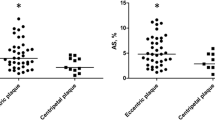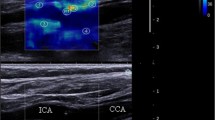Abstract
Objectives
To evaluate the ability of ultrasound non-invasive vascular elastography (NIVE) strain analysis to characterise carotid plaque composition and vulnerability as determined by high-resolution magnetic resonance imaging (MRI).
Methods
Thirty-one subjects with 50 % or greater carotid stenosis underwent NIVE and high-resolution MRI of internal carotid arteries. Time-varying strain images (elastograms) of segmented plaques were generated from ultrasonic raw radiofrequency sequences. On MRI, corresponding plaques and components were segmented and quantified. Associations between strain parameters, plaque composition and symptomatology were estimated with curve-fitting regressions and Mann–Whitney tests.
Results
Mean stenosis and age were 72.7 % and 69.3 years, respectively. Of 31 plaques, 9 were symptomatic, 17 contained lipid and 7 were vulnerable on MRI. Strains were significantly lower in plaques containing a lipid core compared with those without lipid, with 77–100 % sensitivity and 57–79 % specificity (P < 0.032). A statistically significant quadratic fit was found between strain and lipid content (P < 0.03). Strains did not discriminate symptomatic patients or vulnerable plaques.
Conclusions
Ultrasound NIVE is feasible in patients with significant carotid stenosis and can detect the presence of a lipid core with high sensitivity and moderate specificity. Studies of plaque progression with NIVE are required to identify vulnerable plaques.
Key points
• Non-invasive vascular elastography (NIVE) provides additional information in vascular ultrasound
• Ultrasound NIVE is feasible in patients with significant carotid stenosis
• Ultrasound NIVE detects a lipid core with high sensitivity and moderate specificity
• Studies on plaque progression with NIVE are required to identify vulnerable plaques






Similar content being viewed by others
References
Rothwell PM, Eliasziw M, Gutnikov SA et al (2003) Analysis of pooled data from the randomised controlled trials of endarterectomy for symptomatic carotid stenosis. Lancet 361:107–116
Halliday A, Harrison M, Hayter E et al (2010) 10-year stroke prevention after successful carotid endarterectomy for asymptomatic stenosis (ACST-1): a multicentre randomised trial. Lancet 376:1074–1084
Naghavi M, Libby P, Falk E et al (2003) From vulnerable plaque to vulnerable patient: a call for new definitions and risk assessment strategies: part I. Circulation 108:1664–1672
Redgrave JNE, Lovett JK, Gallagher PJ, Rothwell PM (2006) Histological assessment of 526 symptomatic carotid plaques in relation to the nature and timing of ischemic symptoms: the oxford plaque study. Circulation 113:2320–2328
de Weert TT, Ouhlous M, Meijering E et al (2006) In vivo characterization and quantification of atherosclerotic carotid plaque components with multidetector computed tomography and histopathological correlation. Arterioscler Thromb Vasc Biol 26:2366–2372
Tawakol A, Migrino RQ, Bashian GG et al (2006) In vivo 18F-fluorodeoxyglucose positron emission tomography imaging provides a noninvasive measure of carotid plaque inflammation in patients. J Am Coll Cardiol 48:1818–1824
Christodoulou CI, Pattichis CS, Pantziaris M, Nicolaides A (2003) Texture-based classification of atherosclerotic carotid plaques. IEEE Trans Med Imaging 22:902–912
Ainsworth CD, Blake CC, Tamayo A, Beletsky V, Fenster A, Spence JD (2005) 3D ultrasound measurement of change in carotid plaque volume: a tool for rapid evaluation of new therapies. Stroke 36:1904–1909
Cai J, Hatsukami TS, Ferguson MS et al (2005) In vivo quantitative measurement of intact fibrous cap and lipid-rich necrotic core size in atherosclerotic carotid plaque: comparison of high-resolution, contrast-enhanced magnetic resonance imaging and histology. Circulation 112:3437–3444
Cappendijk VC, Cleutjens KBJM, Kessels AGH et al (2005) Assessment of human atherosclerotic carotid plaque components with multisequence MR imaging: initial experience. Radiology 234:487–492
Takaya N, Yuan C, Chu B et al (2006) Association between carotid plaque characteristics and subsequent ischemic cerebrovascular events: a prospective assessment with MRI—initial results. Stroke 37:818–823
Yuan C, Mitsumori LM, Ferguson MS et al (2001) In vivo accuracy of multispectral magnetic resonance imaging for identifying lipid-rich necrotic cores and intraplaque haemorrhage in advanced human carotid plaques. Circulation 104:2051–2056
Fabiano S, Mancino S, Stefanini M et al (2008) High-resolution multicontrast-weighted MR imaging from human carotid endarterectomy specimens to assess carotid plaque components. Eur Radiol 18:2912–2921
Harloff A, Zech T, Frydrychowicz A et al (2009) Carotid intima-media thickness and distensibility measured by MRI at 3 T versus high-resolution ultrasound. Eur Radiol 19:1470–1479
Schmitt C, Soulez G, Maurice RL, Giroux MF, Cloutier G (2007) Noninvasive vascular elastography: toward a complementary characterization tool of atherosclerosis in carotid arteries. Ultrasound Med Biol 33:1841–1858
Maurice RL, Soulez G, Giroux MF, Cloutier G (2008) Noninvasive vascular elastography for carotid artery characterization on subjects without previous history of atherosclerosis. Med Phys 35:3436–3443
North American Symptomatic Carotid Endarterectomy Trial Collaborators (1991) Beneficial effect of carotid endarterectomy in symptomatic patients with high-grade carotid stenosis. N Engl J Med 325:445–453
Grant EG, Benson CB, Moneta GL et al (2003) Carotid artery stenosis: gray-scale and Doppler US diagnosis—Society of Radiologists in Ultrasound Consensus Conference. Radiology 229:340–346
Destrempes F, Meunier J, Giroux MF, Soulez G, Cloutier G (2011) Segmentation of plaques in sequences of ultrasonic B-mode images of carotid arteries based on motion estimation and a bayesian model. IEEE Trans Biomed Eng 58:2202–2211
Maurice RL, Ohayon J, Fretigny Y, Bertrand M, Soulez G, Cloutier G (2004) Noninvasive vascular elastography: theoretical framework. IEEE Trans Med Imaging 23:164–180
Cai J-M, Hatsukami TS, Ferguson MS, Small R, Polissar NL, Yuan C (2002) Classification of human carotid atherosclerotic lesions with in vivo multicontrast magnetic resonance imaging. Circulation 106:1368–1373
Kerwin WS, O’Brien KD, Ferguson MS, Polissar N, Hatsukami TS, Yuan C (2006) Inflammation in carotid atherosclerotic plaque: a dynamic contrast-enhanced MR imaging study. Radiology 241:459–468
Allen JD, Ham KL, Dumont DM, Sileshi B, Trahey GE, Dahl JJ (2011) The development and potential of acoustic radiation force impulse (ARFI) imaging for carotid artery plaque characterization. Vasc Med 16:302–311
de Korte CL, Sierevogel MJ, Mastik F et al (2002) Identification of atherosclerotic plaque components with intravascular ultrasound elastography in vivo. Circulation 105:1627–1630
Shi H, Mitchell CC, McCormick M, Kliewer MA, Dempsey RJ, Varghese T (2008) Preliminary in vivo atherosclerotic carotid plaque characterization using the accumulated axial strain and relative lateral shift strain indices. Phys Med Biol 53:6377–6394
Dempsey RJ, Vemuganti R, Varghese T, Hermann BP (2010) A review of carotid atherosclerosis and vascular cognitive decline: a new understanding of the keys to symptomology. Neurosurgery 67:484–494
Selvin E, Erlinger TP (2004) Prevalence of and risk factors for peripheral arterial disease in the United States: results from the National Health and Nutrition Examination Survey, 1999–2000. Circulation 110:738–743
Saam T, Cai J, Ma L et al (2006) Comparison of symptomatic and asymptomatic atherosclerotic carotid plaque features with in vivo MR imaging. Radiology 240:464–472
Nandalur KR, Baskurt E, Hagspiel KD, Phillips CD, Kramer CM (2005) Calcified carotid atherosclerotic plaque is associated less with ischemic symptoms than is noncalcified plaque on MDCT. AJR Am J Roentgenol 184:295–298
Mathiesen EB, Bonaa KH, Joakimsen O (2001) Echolucent plaques are associated with high risk of ischemic cerebrovascular events in carotid stenosis: the tromso study. Circulation 103:2171–2175
Larsson M, Kremer F, Claus P, Kuznetsova T, Brodin LA, D’Hooge J (2011) Ultrasound-based radial and longitudinal strain estimation of the carotid artery: a feasibility study. IEEE Trans Ultrason Ferroelectr Freq Control 58:2244–2251
Le Floc’h S, Ohayon J, Tracqui P et al (2009) Vulnerable atherosclerotic plaque elasticity reconstruction based on a segmentation-driven optimization procedure using strain measurements: theoretical framework. IEEE Trans Med Imaging 28:1126–1137
Acknowledgments
The authors are grateful to Mrs Vicky Thiffault, Louise Allard and Andrée Cliche for their dedication in study coordination, IRB documentation preparation and patient recruitment. We would like to also acknowledge the contributions of Drs Stéphane Elkouri, Nathalie Beaudoin, Jean-Francois Blair and Eric Therasse in patient recruitment and useful advices. We would also like to thank Madame Marie-Pierre Sylvestre, biostatistician, who guided us through statistical analyses. The authors are also grateful to the Natural Sciences and Engineering Research Council of Canada, the Canadian Institutes of Health Research, Gestion Univalor and Bracco Diagnostics who provided grants to help fund this project.
Dr Gilles Soulez holds a national scientist award from the Fonds de la Recherche en Santé du Québec.
Author information
Authors and Affiliations
Corresponding author
Electronic supplementary material
Below is the link to the electronic supplementary material.
Supplementary Fig. 1
Scatter plots with curve fitting functions of the natural logarithm of strain parameters with % calcium volume (bivariate analysis). (JPEG 306 kb)
ESM 2
(DOCX 17 kb)
Rights and permissions
About this article
Cite this article
Naim, C., Cloutier, G., Mercure, E. et al. Characterisation of carotid plaques with ultrasound elastography: feasibility and correlation with high-resolution magnetic resonance imaging. Eur Radiol 23, 2030–2041 (2013). https://doi.org/10.1007/s00330-013-2772-7
Received:
Revised:
Accepted:
Published:
Issue Date:
DOI: https://doi.org/10.1007/s00330-013-2772-7




